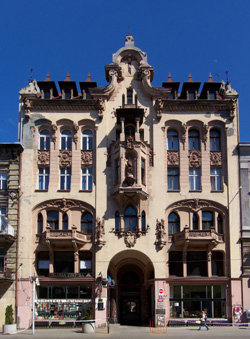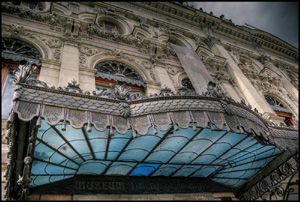
Łódź: Promised Land – Waste Land
By MAGDALENA MODRZEJEWSKA

Łódź, panoramic view of Poznański's factory after renovation.
Łódź is the third–largest city in Poland, but it is rarely listed as a “must–see” place for visitors to Poland. A lot has changed recently, however, so do not make this mistake, and visit Łódź when you have the slightest opportunity!
Łódź was established in the medieval ages, but for many centuries remained a tiny, insignificant village. The development of the textile industry in the nineteenth century was a turning point in the history of the city. During the last hundred years the population has grown to 500,000 people from only 191! Called the Polish Manchester, Łódź would stupefy you with the most remarkable, magnificent and eye–catching industrial architecture you have ever seen. The former Poznański factory, now renovated and transformed into a shopping center, is a unique example of this splendid nineteenth century industrial architecture.

Łódź: 86 Piotrkowska Street.
Łódź can offer much more than just beautiful sight lines, bricks and stones. It has a unique, multicultural atmosphere. Four ethnic groups, Jews, Russians, Germans and Poles, created the wealth of the city, and four religions, Roman Catholic, Orthodox, and Protestant Christianity and Judaism shaped its culture. They lived together for many decades, cooperated with each other, often inter–married , and made business together.
Finally, Łódź developed its own identity – the so called “Lodzermensch”. He/she was a person from Łódź, and surprisingly this identity often was perceived as the primary one. Those who lived in Łódź more willingly identify themselves with the city, and build their identity on that ground, rather than on a national or religious basis. However, this paradise, which had been a Promised Land for many generations of immigrants, was swept away by World War II. The Jews were exterminated, the Germans were evicted, and the Russians were relocated. The industry was irreversibly transformed by nationalization, and the class of factory owners vanished in a few months.
For the many decades of the communist regime, Łódź's cultural heritage was neglected and systematically destroyed. The Promised Land was turned into a waste land. The beautiful city suffered many scares and a crippled soul, but survived. The moment of economic transformation after the collapsed of communism was even more convoluted. The old factories become unprofitable, because there was no demand for their products - before, almost all of their production was sold to the Soviet Union. The factories went bankrupt one by one. The unemployment rate was 16% in the 1990s.

Łódź: Poznański's palace.
Łódź has been trying to rise up from its knees, cultivate a memory of its illustrious past and gain a new, modern look. Łódź became a cultural center, a host place for many celebration and festivals. Among them should be mentioned the Camerimage Film Festival, specifically organized to focus on the art of cinematography, and attended every year by world–renowned cinematographers, and the Festival of the Dialogue of Four Cultures that remembers the multicultural heritage of Łódź.
When you come to Łódź, you might have an impression of ugliness. But a Polish poet, Stanislaw Grochowiak, wrote, “ I prefer ugliness, it is closer to the blood circulation”. When you see Łódź more closely, you will feel that blood circulation, those vibrant emotions, the scars on the soul of the city, and on the souls of the people who lived in it. Łódź is an unforgettable experience.
Dr. Modrzejewska was visiting professor in the Skalny Center in Spring 2010. She is assistant professor in the Institute of American Studies and Polish Diaspora, Jagiellonian University, Kraków, Poland.

